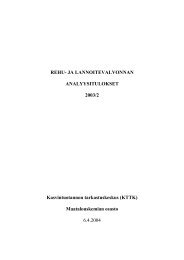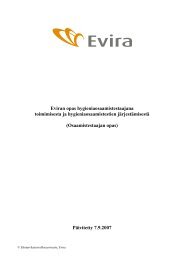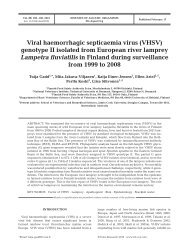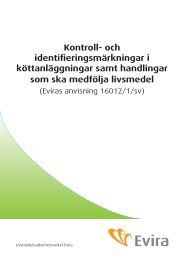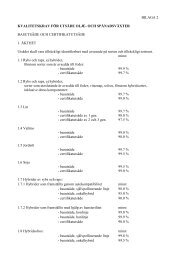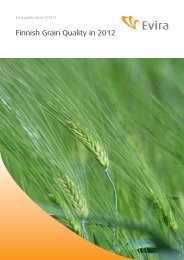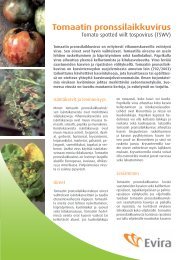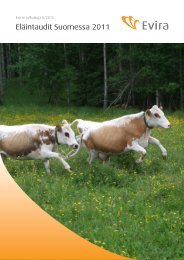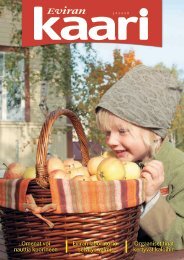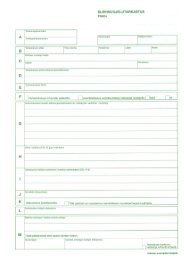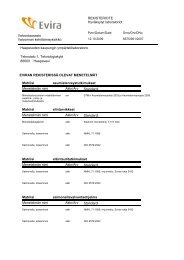Download PDF, 1522 kB - Evira
Download PDF, 1522 kB - Evira
Download PDF, 1522 kB - Evira
Create successful ePaper yourself
Turn your PDF publications into a flip-book with our unique Google optimized e-Paper software.
The percentages of Salmonella-positive fattening flocks of broilers and turkeys are<br />
shown in Figure 1, and total numbers in Table 19. In 1995, the overall proportion<br />
of positive flocks was in excess of 3 %. After that, their combined proportion<br />
remained well below 1 %, except for a rise in 1999 (2.1 %). Besides contamination<br />
originating in broiler hatcheries, the increase in 1999 was also affected by the<br />
inclusion of pre-enrichment in the analysis of samples. After 1999, the proportion<br />
constantly declined and was only 0.15 % in 2004.<br />
Serotypes isolated fattening flocks of broilers and turkeys are shown in Tables 20.<br />
and 21. Around 10 serotypes were identified in broilers and seven in turkeys. The<br />
most common serotype in broilers during 1996 - 2004 was Infantis, but Livingstone<br />
has been most frequently isolated serotype since 2001. Typhimurium was<br />
isolated from only one fattening flock in 2001 (DT 1) and Enteritidis did not at all<br />
occur in broilers from 1996 to 2004. The most common serotype among turkeys<br />
has been Typhimurium, and Enteritidis was isolated from turkeys in three years.<br />
Enteritidis strains were of phage type DT 4 (Table 22), and the most common<br />
phage type of Typhimurium strains was DT 1 (Appendix 1).<br />
The percentages of Salmonella-positive samples of poultry meat are shown in Figure<br />
2. In 1995, they represented 9.4 %; since 1998, the proportion constantly has<br />
been below 0.8 %, and from 2000 onwards, 0.2 % or less. Not even the increase<br />
in the number of positive fattening flocks in 1999 raised the number of positive<br />
meat samples, Hence, it can be deducted that more efficient cultivation methods<br />
have prevented Salmonella-contaminated meat from reaching consumption.<br />
Näytteitä kpl / No of samples<br />
1200<br />
1000<br />
800<br />
600<br />
400<br />
200<br />
0<br />
2.4.3 Discussion<br />
Siipikarja / Poultry 1995-2004<br />
1995 1996 1997 1998 1999 2000 2001 2002 2003 2004<br />
Siipikarjan liha / poultry meat<br />
Salmonella control of poultry is primarily based on the control of production<br />
farms and prevention of Salmonella infection. Controlling primary production and<br />
regular sampling is particularly important poultry, as Salmonella infections are<br />
not generally as evident as diseases in animals. Faecal samples from broilers,<br />
turkeys and laying hens are analyzed in all stages of production, and hatcheries<br />
are also regularly examined for Salmonella. Thus, the objective is to detect Salmonella<br />
infections in the early stages before broilers and turkeys are slaughtered<br />
or prior to laying eggs. This efficiently lessens the probability of eggs or meat<br />
contaminated by Salmonella reaching consumption. In addition, meat samples<br />
taken from the production line are regularly examined in cutting plants.<br />
Salmonella control and occurence of Salmonella from 1995 to 2004<br />
10<br />
9<br />
8<br />
7<br />
6<br />
5<br />
4<br />
3<br />
2<br />
1<br />
0<br />
% positiivisia lihanäytteitä / % positive meat samples<br />
% positiivisia / % positive<br />
Figure 2. National Salmonella<br />
Control Programme: Occurence<br />
of Salmonella in poltry samples in<br />
1995 - 2004



